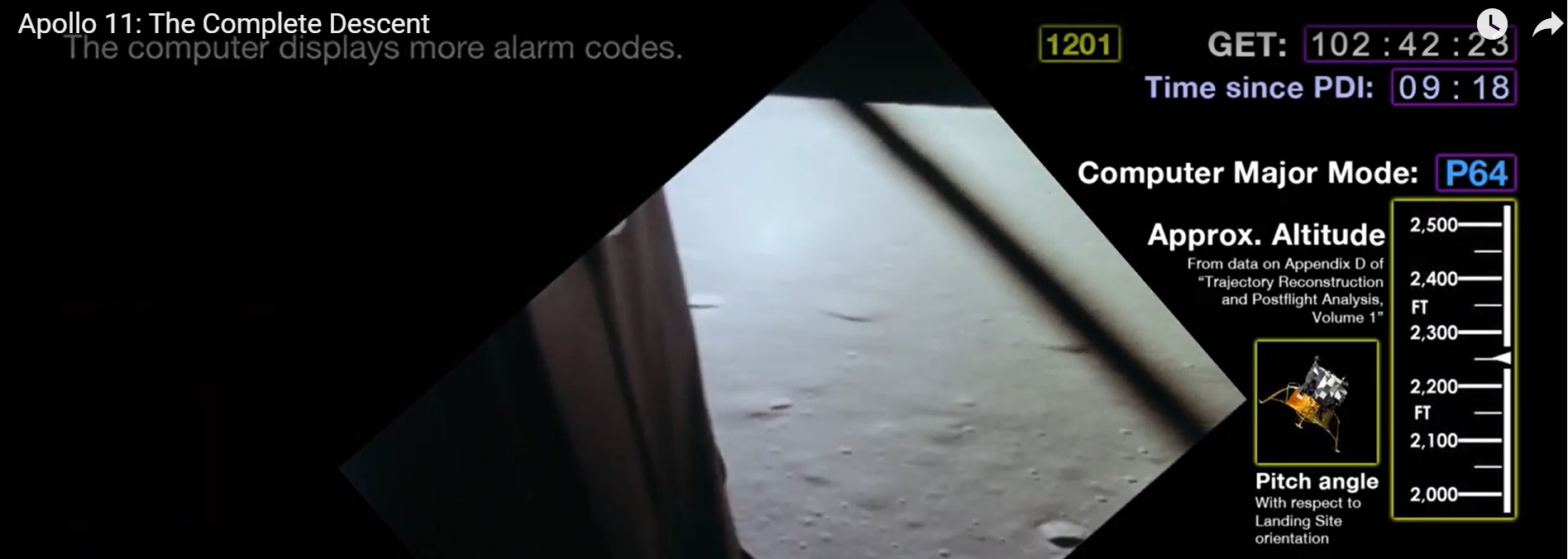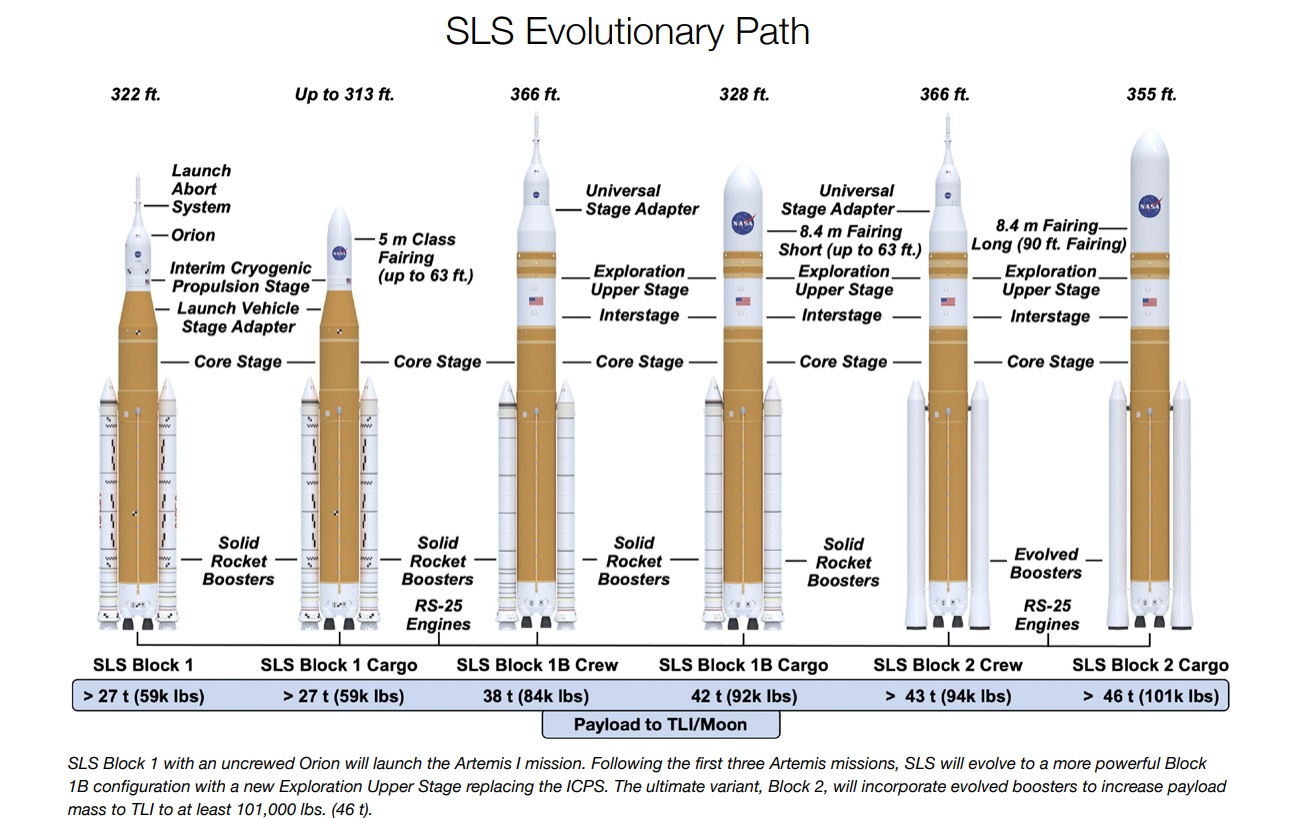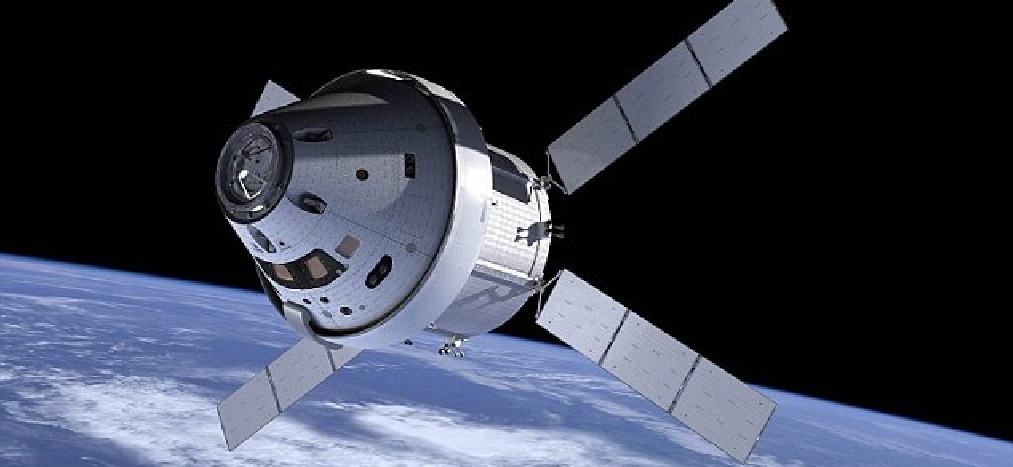I was pleased to hear about the Artemis space programme. NASA tell us that “Artemis is the first step in the next era of human exploration. Together with commercial and international partners, NASA will establish a sustainable presence on the Moon to prepare for missions to Mars”. That sounds good to me, because the future isn’t what it used to be, and going back to the Moon is like going back to the future. I have fond memories of the Apollo space programme:
 Public domain images courtesy of NASA: Saturn V, Apollo spacecraft, and docking and extraction of lunar module
Public domain images courtesy of NASA: Saturn V, Apollo spacecraft, and docking and extraction of lunar module
At the top of the mighty Saturn V was the Launch Escape System or LES, which would be jettisoned after launch. Underneath that was the Command Module, the capsule. Underneath that was the Service Module, which together with the Command Module made up the Command and Service Module or CSM. Underneath that was the Lunar Module or LM shielded by adapter panels. These would later be jettisoned so that the CSM could turn round and dock nose-first with the LM. The top four components made up the Apollo spacecraft, underneath which were the three rocket stages.
That’s one small step for a man, one giant leap for mankind
As everybody knows, the first Moon landing was of course Apollo 11 on July 20 1969. The Lunar Module or “Eagle” was crewed by Neil Armstrong and Buzz Aldrin, whilst Michael Collins stayed up in the Command Module or “Columbia”. I watched it all on TV. I remember “The Eagle has Landed”. See the NASA article for the details: 50 Years Ago: One Small Step, One Giant Leap. Funnily enough what I don’t remember was that there was no live TV coverage of the actual landing. We had to wait for a 16mm film to be developed after the mission got back. Eventually though, there was a video of the landing, and excellent stuff it was:
 Screenshot from the Apollo 11 the complete descent video, courtesy of NASA
Screenshot from the Apollo 11 the complete descent video, courtesy of NASA
Like everybody else who lived through it, I recall the moment that man stepped foot on the Moon. Here’s the transcript: “Once on the ladder, Armstrong pulled a lanyard that released the Modularized Equipment Stowage Assembly (MESA) on the side of Eagle’s Descent Stage, on which was mounted a black and white TV camera, allowing hundreds of millions of viewers on Earth to see him descend the ladder down to the landing leg’s footpad. As a precaution, he practiced the three-foot jump back up to the ladder’s first rung, made easier in the one-sixth lunar gravity. Once back down on the footpad, Armstrong described that the footpads had only sunk one or two inches into the lunar dust which he noted was fine-grained, almost powdery. Armstrong announced, “I’m going to step off the LM now.” And at 9:56 PM Houston time he did just that, firmly planting his left foot onto the lunar surface, proclaiming, “That’s one small step for a man, one giant leap for mankind.”
The future was bright
It was all rather low-resolution black and white footage, but it was an historic moment, one that made me feel so proud and optimistic for the future. It was the same for everybody else. The things that post-war boys had seen in their comics and on TV were coming true. The Mercury space programme started in 1958, only 13 years after all the hardship and sacrifice of World War II. The Gemini space programme started in 1961, only 15 years after World War II. The Apollo space programme started in 1963*, only 18 years after World War II. The future was bright. A mere 24 years after World War II, man was on the Moon. It was a great achievement, one that went down in history, and shaped an awful lot of lives, including mine.
 Screenshot from the Neil Armstrong’s first steps on the moon video, courtesy of NASA
Screenshot from the Neil Armstrong’s first steps on the moon video, courtesy of NASA
The 1950s were the Boys Own years of Dan Dare, the legendary space hero in the Eagle comic. Like yours truly, Dan was born in Manchester. He was also bound by a sense of honour, never lied, and would rather die than break his word. The 1960s gave us Fireball XL5, then Stingray, then Thunderbirds. They were the years of True Grit, when England won the World Cup. When astronauts were made of the Right Stuff. When men were men and people faced up to danger and got things done. Big things. The Saturn V was 363 feet tall, one foot shorter than St Paul’s Cathedral, which was London’s tallest building for two hundred and fifty years until 1963. The NASA administrator at the time was of course James E Webb, after whom they named the space telescope.
They were asphyxiated by high concentrations of carbon monoxide
Sadly three crew members were killed in 1967 in a capsule fire atop Apollo 1. They were Gus Grissom, Ed White, and Roger Chaffee. It was a tragic event, and a grim story in its own right. Pure oxygen is dangerous, especially at high pressure in the presence of material that doesn’t normally burn. Especially when there were no explosive bolts like there were on Grissom’s Mercury capsule. That sank after splashdown on July 21, 1961 because the hatch blew off prematurely. See Space Myths Busted: Gus Grissom Didn’t Blow The Hatch on Liberty Bell 7. The Apollo 1 hatch was difficult to open, all the more so because it opened inward, and because the oxygen in the command module was at a pressure of 16psi. On top of that the pressure increased to 29psi due to the fire. They couldn’t get out. Note this: “The NASA crew systems department had installed 34 square feet (3.2 m²) of Velcro throughout the spacecraft, almost like carpeting. This Velcro was found to be flammable in a high-pressure 100% oxygen environment. Astronaut Buzz Aldrin states in his book Men From Earth that the flammable material had been removed per the crew’s August 19 complaints and Joseph Shea’s order, but was replaced before the August 26 delivery to Cape Kennedy”.
 Images courtesy of NASA: 1) Backup crew in training, McDivitt, Scott and Schweickart 2) The fire-blackened Apollo 1 capsule
Images courtesy of NASA: 1) Backup crew in training, McDivitt, Scott and Schweickart 2) The fire-blackened Apollo 1 capsule
There are pictures of the bodies online if you’re interested. If it’s any consolation they didn’t burn to death. They were asphyxiated by carbon monoxide after the fire melted their oxygen tubes. They were unlucky, because more Apollo astronauts died in aircraft crashes than on the job. Whilst some say 13 is an unlucky number, I’d say the Apollo 13 crew were lucky. After the explosion in an oxygen tank in April 1971, they made it home. So did all the other Apollo crews.
And that, was that
Apollo 12 landed on the Moon in November 1969. Apollo 14 landed on the Moon in January 1971. That’s when Alan Shepherd played golf and Edgar Mitchell threw a javelin. Then Apollos 15 and 16 landed on the Moon in July 1971 and April 1972 respectively:
 Screenshot from the Wikipedia article Apollo program
Screenshot from the Wikipedia article Apollo program
The last mission was Apollo 17. It launched on December 7 1972, crewed by Eugene Cernan, Ronald Evans, and Harrison Schmitt. They took the famous Blue Marble picture as they headed out from Earth. Cernan and Schmitt landed on the Moon on December 11. Like the previous two missions they had a lunar rover. After three Earth days on the Moon they took off on December 14, then after some deep-space EVA, they all splashed down in the Pacific on December 19. And that, was that. That was the end of the Apollo space program. Fifty years ago. It was fifty years ago when man last walked on the moon. Of those twelve good men, eight are dead. Neil Armstrong died ten years ago. Buzz Aldrin is ninety two. Our heroes are receding into history.
Skylab was an Apollo spinoff
There were other NASA activities of course. There’s been a whole host of uncrewed NASA missions, such as Voyager, Galileo, the Hubble Space Telescope, Discovery, Cassini, the Mars Exploration Rover, and the James Webb Space Telescope to name but a few. These are great missions that have advanced our knowledge greatly, and it would take a me a whole host of articles to do them justice. That’s if I could, because all I could give is a reheat**. And even if I could, the fact remains that they’re not manned missions. Skylab was. See the List of NASA missions on Wikipedia. Skylab was an Apollo spinoff, launched in May 1973. But it was only occupied three times, and fell to Earth in 1979 scattering debris in the Indian Ocean and Western Australia. In addition the Space Shuttle program ran from 1981 to 2011 and achieved some great things. But it was only ever a low-Earth orbit, the payload wasn’t great, and there were the Challenger and Columbia disasters in 1986 and 2003:
 Columbia re-entry debris, picture by Dr. Scott Lieberman
Columbia re-entry debris, picture by Dr. Scott Lieberman
A reusable spaceplane re-entering the atmosphere at circa 17,500 mph is vulnerable. Especially when it has little fuel left and the aerodynamic qualities of a brick. A piece of insulating foam falls off the main fuel tank, it damages the wing, and then the heat of re-entry creates a blowtorch inside that wing. NASA haven’t solved the problem, so they’ve gone back to fifty-year-old rocket science.
Artemis was Apollo’s twin sister
That’s why we now have the Artemis programme. In Greek mythology, Artemis was Apollo’s twin sister. The Artemis program uses the Space Launch System or SLS rocket. Whilst the Artemis I SLS isn’t quite as big as the Saturn V, it’s still a brute at 322 feet tall. Especially since it delivers 8.8 million pounds of thrust as opposed to the Saturn V’s 7.6 million pounds of thrust. Especially since future versions are envisaged to be 366 ft tall:
 SLS evolutionary path image from the NASA Space Launch System Reference Guide
SLS evolutionary path image from the NASA Space Launch System Reference Guide
The SLS is topped by the Orion spacecraft which consists of a Launch Abort System, a Crew Module, and a Service Module. It’s the same general plan as Apollo’s Command and Service Module. However the Service Module is provided by the ESA and is known as the European Service Module or ESM. That sounds odd. Why can’t NASA come up with their own service module? It looks odd too. It looks like the ESM is too small for the Crew Module:
 Orion spacecraft artist’s impression courtesy of NASA
Orion spacecraft artist’s impression courtesy of NASA
That doesn’t auger well. Something else that doesn’t auger well is that the lunar module is not currently defined. See NASA Awards SpaceX Second Contract Option for Artemis Moon Landing dated 15/11/2022. It says this: “NASA initially selected SpaceX to develop a human landing system variant of Starship to land the next American astronauts on the Moon under Artemis III, which will mark humanity’s first return to the lunar surface in more than 50 years. As part of that contract, SpaceX will also conduct an uncrewed demonstration mission to the Moon prior to Artemis III”.
The only thing it does reliably, is crash and burn
Yes, one option is to use a SpaceX Starship to ferry the astronauts down to the lunar surface and then back up. Which brings my Artemis happiness to a record-screeching halt. Because whilst I like Elon Musk, I do not like his “starship”. That’s because the only thing it does reliably, is crash and burn:
 Screen shots from SpaceX recordings
Screen shots from SpaceX recordings
Another option is for a Lunar Module more like the Apollo Lunar Module. But that ought to remind you that the spacecraft on top of Artemis I is the Orion spacecraft. It isn’t the Artemis spacecraft. It doesn’t include a Lunar Module. You’d think that after fifty years NASA would have this all worked out. They’d have an Artemis spacecraft with a Command Module in the form of a detachable nose cone. The underside of this would be a robust heat shield for re-entry. There would also be a hatch leading through to some more comfortable crew quarters and workspace. Then there would be another hatch giving access to the Lunar Module. This would sit inside the payload doors of the Service Module. What’s not to like? Add a few solar panels and a fuel tank or two, and it would start looking like The Hermes in The Martian. That would be a good start.
As far as I can see there is no vision of an Artemis spacecraft
But that’s not what we’ve got. There is no Artemis spacecraft. And as far as I can see there is no vision of an Artemis spacecraft. That definitely doesn’t auger well. What we’ve got right now is a cobbled-together hodge-podge of a progamme, using bits and pieces from here and there to make some kind of political statement and put down a marker. We have airy fairy talk of Gateway, a space station orbiting the Moon. To be supplied by the SpaceX Dragon X. And supplemented by the Human Landing System which appears to be that SpaceX starship. That’s devolving responsibility and putting things off, and not knuckling down to the task in hand. No small wonder six out of ten Artemis cubesats have gone AWOL. See Matt Strassler talking about that here. No small wonder there’s criticism. This isn’t Moon Direct. This isn’t the right stuff. This is the wrong stuff. And my oh my, what do we have here? The NASA Artemis web page says “NASA will land the first woman and first person of color on the Moon”. Oh FFS.
 Artemis screengrab from the NASA Artemis website
Artemis screengrab from the NASA Artemis website
Virtue signalling is no substitute for picking the best people you can get. If you don’t do that, there’s an increased risk that the world will watch as the crew dies shrieking and screaming in a spectacular ball of flame. Then the media will have a feeding frenzy of hand-wringing recrimination that will put “the Artemis generation” back into their safe space, and put Artemis into an early grave. I love you NASA, but come on, get a grip. Do away with the danger. Move on from the fifty-year-old rocket science. Take a tip from the USAF and their little blue book. Take a tip from Mark Watney, and science the shit out of this. Start by understanding the fundamental physics. For example, when you have two currents going the same way down two parallel wires, those wires attract. It’s only a small residual force because most of the raw Coulomb forces cancel, but not quite. We call it electromagnetism. Then when you stop the currents, the wires still attract, but with an even smaller residual force. About 10³⁶ times smaller. Because now even more of the raw forces cancel, but not quite. Only now we don’t call it electromagnetism any more. We call it gravity.
Edit 11/12/2022: I was pleased that the Artemis I capsule splashed down successfully. Here’s a video showing the mission highlights: Artemis I Mission Highlights – YouTube. Back to the Moon and beyond!
* Some sites say the Apollo programme started in 1961, others say it started in 1962.
** I suppose this article is a reheat. Sorry about that.
Thanks for another highly educational article John. Your non-reaction to this years Nobel Dyn-O-Myte Award was splendidly expected by myself.
Guess what else other great things came from Manchester,UK. ? ( besides football ⚽️) . And that would be graphene ! But you already knew that.
Unfortunately, NASA has down through the years become just another US Gov’t Mule of a bureaucracy.
And don’t get me started on Elon Musk. Isn’t he a perfect James Bond caricature of the evil, obscenely wealthy megalomaniac bent on taking over world ?
Now how about some real science : all the gardening I been doing this year got me to revisit the fascinating subject of photosynthesis. Boy howdy there sure was an awful amount of new info to read up on. The Wikipedia articles all start off very promising, but then the authors can’t come up with a reasonable hypothesis of how the photons are captured and then directed to the electron transport chain without using 1929 SM baloney( virtual photons
again !) However after just casual looking at a drawing of a chloroplast, I immediately realized that the external membrane is quite possibly the very first polarizing mechanism, followed by the stroma (chemical soup liquid) as well ? This offers up a better explanation of how the proper wavelength photons are channeled to the fascinating electron transport chain in the thylakoid lumens.
Do you, or anybody else, think I am on the correct path here ? A future article on photosynthesis would be much appreciated 👏 John.
P.S. , I hope the Brexit mess has gotten better, hope your doing better than tRUMP has in Federal and States courts. Keep well 🙏 ✨ 😊 y’all !
My pleasure Greg, and thanks. I will write about the Nobel prize later this month. Sure I know about the graphene, see https://www.graphene.manchester.ac.uk/ngi/. Not that I have any special knowledge about it. That’s sad if NASA has morphed into a bureaucracy. I guess a lot a big organisations go that way. It’s certainly happened to our NHS. The joke was that the NHS had so many managers they could have one standing at the end of every bed. Now I suspect they could have one standing at every corner of every bed. As for Elon Musk being a Bond villain, he’s a free-speech whistle-blower hero, not a villain. Even if he was, he’s not a patch on Max Zorin, and he doesn’t have a) a swivel chair, b) a cat, and c) a hollowed-out-volcano with a monorail, a shark tank, and a death ray. All these things are on my bucket list, LOL!
.
I don’t know the details of photosynthesis I’m afraid. I deal in the fundamental physics. Chemistry is above my pay grade, and biochemistry is way above my pay grade. But I might look into it sometime. For now I will tell you this for nowt: photosynthesis converts energy into matter. Not much, but some. It’s the opposite of a fire, which converts matter into energy. Not much, but some. Newton knew about this. Smart guy was Newton. Meanwhile see https://physicsdetective.com/what-energy-is/ for a bit about energy. Suprisingly enough, chemical energy is bond energy which is spring energy. I kid ye not. As for whether you’re on the correct path, I don’t know. Sorry!
.
It’s not really a Brexit mess. It’s a Conservative government mess. Our Conservative government is a useless idiocracy. They can’t get anything right. Which is why the Conservative party is heading for total extinction in two years time. As for what happens after that, I’m not sure. We shall see. But for now, I would say this: our Labour party has been dreaming of power for so many years that they won’t be handing it over to the EU any time soon. There are things these guys want to do, and the situation here could end up like certain places in California. Hence Australia is looking rather attractive at the moment. I just wish I had enough money to buy an island!
Greg I’m not sure what you mean by polarizing mechanism in photosynthesis? The photons are captured by antenna systems (which are chlorophyll pigments) simply by virtue of their absorption properties. This excitations are passed between chlorophylls in proximity until it reaches the reaction center, where the excitation of the molecules are then used to create a charge separation. This charge separation is then used as an energy source for carbon capture and water oxidation by metal centers. There’s nothing involving virtual photons baloney. If anything, the mystery is in the efficiency of the charge separation (the excited state has a very short half-life, so you need a fast transfer of energy to avoid charge recombination), but that is related to geometrical fine tuning of the protein structure, not quantum field theory. Perhaps you could ask why photons interact with molecular orbitals at all, but that is a rather general question and not exclusive to photosynthesis.
Oh hell yea , photosynthesis is way above my pay grade too. LOL !
I was just hoping to pique your interest on the very beginning process of when photons first enter a chloroplast. How does the proper wavelength photon get screened and selected? I still think it starts with the possible polarization/refraction of the incoming light waves. Absolutely no hypothesis offered on how incoming waves are effectived. Then the Wikipedia articles pickup from there with plenty of pertinent info on the entire biochemical process after the photons reach the thylakoid lumens. No need to compose another redundant War & Peace size tome all of that ! LOL ! No hurries on my end.
I’ll have a look at it Greg. A lot of stuff that sounds complicated is simpler than you think. There is less to it than meets the eye! But maybe on this one, I might be wrong…
.
I note that the Artemis should be splashing down soon: https://blogs.nasa.gov/artemis/2022/12/08/artemis-i-flight-day-23-mission-teams-prepare-for-splashdown-select-landing-site/
Hi Guys
In the late sixties and early seventies, I researched the possible causes of photosynthesis. Because most of the photosynthesis occurred in green materials being leaves and grass etc. this became the focus of my investigation. My conclusion was that the green pigmentation was partly, if not totally, responsible for the effect, acting perhaps as a liquid crystal filter that allowed the absorption of carbon dioxide and the elimination of oxygen as unused waste.
Unfortunately, that paper and others disappeared when my car was burglarized, and I never bothered to rewrite them. I hope this helps.
Did your paper get published, Jack? If so maybe it’s on the internet somewhere.
Jack, thanks as well !
Sandra, thanks for your input. For clarification I need to state that I am not a scientist or any type of academic. Therefore I don’t always connect the dots very quickly or easily.
I failed to perceive the antenna systems you mention. Their filtering of the correct wavelength of photons(along with other internal processes?) is what has piqued my interest. Is it just blind luck of waiting for the completely random, correct wavelength photons to show up and interact(a passive system), or is there a more precise, efficient,and complex filtering process involved ? One that starts to manipulate the photons as soon as they first enter the cell ( aggressive system) ?
All the 1929 Standard Model mumbo-jumbo is offered up in one of the many Wikipedia sub-articles on photosynthesis as the “correct explanation” on how the electron transport train is thought to work.
Please bear with me, being a Savant is hard wurk….greater minds than my own are greatly appreciated.
An antenna system is simply a molecule that can absorb a certain frequency of light. There’s no filtering, you just need the right type of photons present (of the correct wavelenght). Molecules have electrons all over them, and their configuration (which can be calculated by plain old quantum mechanics, no need for QFT or standard model) creates what are called molecular orbitals, analogous to the orbitals in single atoms. When a photon of the right frequency interacts with the molecular orbital, the electron (or multiple) will jump to next empty orbital higher in energy. When it decays, it emits the same frequency photon it absorbed (exactly like in an atom). The fact that it’s an extended system though lets you make way more complicated jumps, even between orbitals of adjacent molecules.
In plants, the antenna molecules are chlorophylls. They convey the photon energy through successive jumps to a reaction center inside a photosystem, which is a protein complex that is able to transform that energy in a free radical (a loosely bound electron, which is extremely reactive). This is what is called “charge separation”, the electron is then used to pump protons (to make ATP), oxidize water and capture carbon. This is still a somewhat simplified view, but gives you the gist.
Greg: if I might add, start with Compton scattering wherein a “slice” of the incident photon is transferred to the electron, which is then no longer symmetrical. As a result the closed path no longer ends up at the same place, so the electron moves. Now think of the electron in an orbital as something like a tetherball. It moves up to the next orbital. But only if that orbital is the next gear, as it were. Otherwise is doesn’t make it, and sheds the photon and drops back.
Sandra, your teaching skills are exemplary and greatly appreciated. If you don’t already contribute to Wikipedia, then you definitely should ! You dumbed it down just enough for me to get a much better understanding.
And John, revisiting Compton scattering helped a lot too! Question: whilst the photons in the soliton wave packets are spiraling L or R in a line exactly like a fired bullet ? Is the “a slice of” energy transfer from incident photon the same as/or caused by old fashion torque ?
I agree with Jack and think a lot more is happening to other wavelengths of photons before the chloroplasts are reached.
Question: whilst the photons in the soliton wave packets are spiralling L or R in a line exactly like a fired bullet?
.
I’m not sure Greg. But I don’t think so. I think the neutrino and the antineutrino has the L or R spiralling motion. See hyperphysics: http://hyperphysics.phy-astr.gsu.edu/hbase/Particles/neutrino3.html. Then see https://physicsdetective.com/the-photon/ and read the section on photon spin. I said “It’s like the circular-polarized photon is an arrow with one set of flights set behind the other. But this arrow isn’t spinning like a bullet. Your washing line isn’t spinning on its long axis like some drive shaft. For a better picture imagine you could lean out of an upstairs window with a whip in your hand. Move the handle quickly in a growing circle that then diminishes to make a wave that corkscrews down the whip, something like this”. However I’m not sure about this. The place to start with physics is the photon, but I’m still not sure what it is.
.
Is the “a slice of” energy transfer from incident photon the same as/or caused by old fashion torque?
.
I don’t think so. I think it’s more of a wave superposition followed by a separation, wherein the two operations are not symmetrical. For example 511 keV + 3 keV = 514 keV → 512 keV + 2 keV. But again, I’m not sure.
With cost-plus, the incentive is very obviously to drag everything out as long as possible. And so it does. Every. Single. Time.
Above quote from comments section of:
https://arstechnica.com/space/2023/06/weirdly-a-nasa-official-says-fixed-price-contracts-do-the-agency-no-good/
PS
Do you see Daleks
I am retired from the transportation/logistics industries; my take is: cost plus contracting is a truly lazy upper management approach to make their own administrative duties as carefree as possible. With grift automatically built into the system it makes for a more gutless management style. What is worse: it took lots of crooked political lobbying for this to be implemented to begin with. Talk about a perfect perpetual motion machine !
May the Daleks feast gluttonously on NASA……
Ditto that.
I worked on radar and sonar in the Cold War days. I was told a story that one guy spot welded an Alan Wrench onto a T handle so he could easily calibrate the antenna. Air Force saw it and said they wanted it, We said Sears Craftsman 50 cents help yourself. But nooo, they wanted us to build an official tool, told them $25,000. We actually lost money on it by the time manuals were written training accomplished certification etc etc.
Re gutless mgmt – 10000 attaboys are wiped out by one aw shit . Bureaucrats are very risk averse.